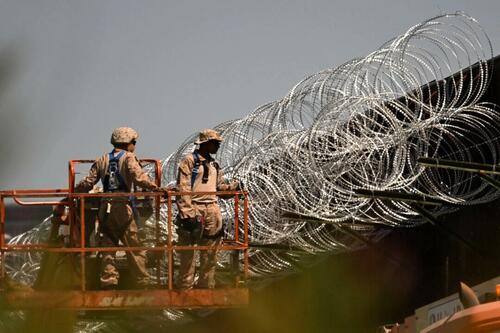Pentagon Review Of Close Combat Training Standards Is Long Overdue
Authored by Elaine Donnelly via RealClearDefense,
Ten years have passed since the Department of Defense initiated a social experiment with women in the military. Pentagon officials promised that female trainees headed for previously all-male combat arms units would have to meet the exact same standards as men. Has the experiment played out as promised?
We are about to find out. Secretary of Defense Pete Hegseth’s March 30 Memorandum calls for a 60-day review to achieve high, uncompromised standards in combat arms units such as the infantry, Special Operations, and other occupations with extraordinary physical demands.
Thanks to a series of Executive Orders that President Donald Trump has issued since January, Hegseth’s 6-month implementation period should proceed without equivocation or distractions related to percentage-based diversity, equity, and inclusion (DEI) quotas. Wrote Hegseth, “[I]t is essential to identify which positions require heightened entry-level and sustained physical fitness.”
An honest review of contemporary policies regarding women in the military should reflect sound priorities unrelated to DEI. Career opportunities are important, but if there is a conflict, the needs of the military must come first.
Direct Ground Combat Goes Beyond “In Harm’s Way”
As the Center for Military Readiness stated in this CMR Policy Analysis, implementation of Hegseth’s order must begin with clear definitions of terms, starting with “direct ground combat.” (DGC). Direct ground combat arms units such as the infantry, armor, artillery, and Special Forces in all branches of the service are trained to seek out and attack the enemy with deliberate offensive action.
Physical demands in DGC units typically are greater than those in units and military occupational specialties (MOSs) that serve “in harm’s way” in war zones. Men and women serving in such roles are at risk of contingent or incident-related combat, and those that come under fire are trained to fight back and return to base. Their mission, however, is not to seek out and engage the enemy with deliberate offensive action.
Medical technicians, truck drivers, intelligence teams and other support troops serve with courage, and all must be prepared for wartime contingencies. More than 150 military women died during war operations in the Middle East since 9/11, including two female Marines who were killed by a suicide bomber during America’s chaotic withdrawal from Afghanistan in 2021.
It is not necessary, however, for all personnel to meet the same physically demanding standards as infantry, armor, artillery, or Special Operations forces. Nor should tough standards in those units be lowered or “redefined” to meet DEI goals.
Empirical Data Ignored
Secretary Hegseth’s review of contemporary training requirements also requires an honest review of recent history. In 2015, Secretary of Defense Ashton Carter elevated “equity” above reality when he opened to women all units and military occupational specialties, including previously all-male infantry, Air Force Special Forces, Army Green Berets and Navy SEALs.
In doing so, Carter disregarded empirical data indicating that his egalitarian policies would compromise standards and effectiveness in close combat units.
From 2012-2015, the Marine Corps conducted a scientific study of the issue, which included nine months of field tests overseen by the University of Pittsburgh. The purpose of the research was to prove a simple hypothesis: “An integrated unit under gender-neutral standards will perform equally as well as a gender-restricted unit.”
However, as CMR wrote in a Statement for the Record of a Senate Armed Services Committee hearing on February 2, 2016, despite positive expectations for field tests conducted with well-qualified female and average male volunteers, USMC field test data disproved the hypothesis. A Summary of empirical data and still relevant findings gathered by the Marine Corps’ Ground Combat Element Integrated Task Force (GCEITF) during that study reveals facts that are very relevant to discussions today.
For example: All-male task force teams outperformed their mixed-gender counterparts in 69 percent (93 of 134) of ground combat tasks. Physical differences were more pronounced in “specialties that carried the assault load plus the additional weight of crew-served weapons and ammunition.”
In gender-mixed units, physical deficiencies had negative effects on the unit’s speed and effectiveness in simulated battle tasks, including marching under heavy loads, casualty evacuation, and marksmanship while fatigued. Significant differences also were noted in the mixed-gender units’ ability to negotiate obstacles and evacuate casualties, and musculoskeletal injury rates were double – 40.5% for females, compared to 18.8% for men.
These results supported a Memorandum from then-Marine Commandant Gen. Joseph Dunford to keep some close combat units all-male. Secretary Carter ignored the Commandant’s rational request and opened all close combat positions to women for purposes of “equity.”
When “Equality” is not Equal
Secretary Carter also promised to maintain sex-neutral (identical) training standards for the combat arms, but that promise proved impossible to keep.
In 2019, the army began trials with a more challenging six-event Army Combat Fitness Test (ACFT) to replace the long-standing Army Physical Fitness Test (APFT). The ACFT was supposed to have sex-neutral (identical) requirements and scoring systems for both male and female trainees.
However, due to high failure rates among the women, officials tried to improve pass rates by removing the most demanding elements of the ACFT, altering scoring systems, or making some events optional.
Women’s scores improved, but DoD contractor RAND acknowledged in its December 2024 report that tougher standards for combat arms units “may be too high to achieve the Army’s desired pass rates for various ‘subgroups’ (the largest being women). Ultimately, the Army reinstated sex-normed (different) standards while pretending that nothing had changed.
Physical realities shattered unrealistic theories about sex equality in the combat arms. This is why Secretary Hegseth is correct in directing the various services to clearly define combat arms occupations and provide tough training that saves lives and missions.
Standards for these roles, Hegseth noted, “should emphasize the ability to carry heavy loads, endure prolonged physical exertion, and perform effectively in austere, hostile environments. Service members in these roles must exhibit speed, strength, agility, and endurance to navigate the demands of combat situations.”
All branches of the service should produce honest evaluations of entry-level and advanced training requirements needed in close combat units and MOS’s. Officials also should determine realistic requirements for other troops who must be prepared for wartime contingencies or hostile incidents while serving “in harm’s way.”
The goal should be to strengthen combat effectiveness, not to advance individual careers or percentage-based demographic quotas.
Elaine Donnelly is President of the Center for Military Readiness (CMR), founded in 1993, following her service on the 1992 Presidential Commission on the Assignment of Women in the Armed Forces. CMR is an independent public policy organization that reports on and analyzes military/social issues.
Tyler Durden
Thu, 04/17/2025 – 22:00
















